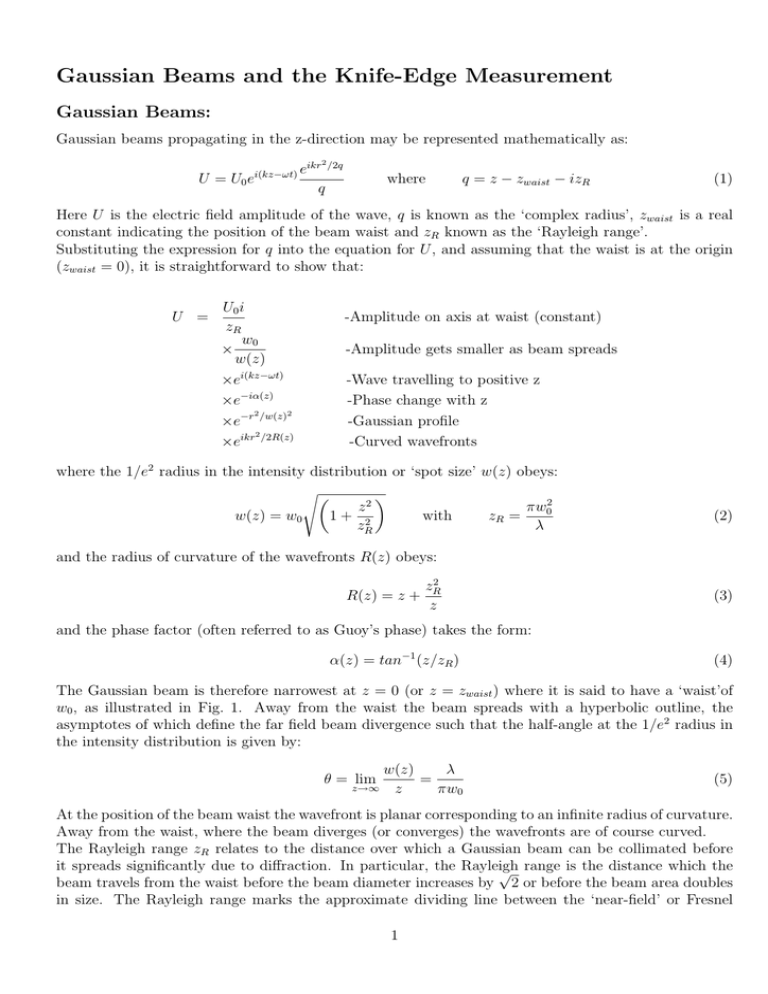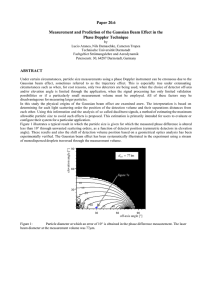Gaussian Beams & Knife-Edge Measurement: Optics Article
advertisement

Gaussian Beams and the Knife-Edge Measurement Gaussian Beams: Gaussian beams propagating in the z-direction may be represented mathematically as: 2 U = U0 ei(kz−ωt) eikr /2q q where q = z − zwaist − izR (1) Here U is the electric field amplitude of the wave, q is known as the ‘complex radius’, zwaist is a real constant indicating the position of the beam waist and zR known as the ‘Rayleigh range’. Substituting the expression for q into the equation for U , and assuming that the waist is at the origin (zwaist = 0), it is straightforward to show that: U = U0 i zR w0 × w(z) ×ei(kz−ωt) ×e−iα(z) 2 2 ×e−r /w(z) 2 ×eikr /2R(z) -Amplitude on axis at waist (constant) -Amplitude gets smaller as beam spreads -Wave travelling to positive z -Phase change with z -Gaussian profile -Curved wavefronts where the 1/e2 radius in the intensity distribution or ‘spot size’ w(z) obeys: s πw02 z2 with zR = w(z) = w0 1+ 2 zR λ (2) and the radius of curvature of the wavefronts R(z) obeys: R(z) = z + zR2 z (3) and the phase factor (often referred to as Guoy’s phase) takes the form: α(z) = tan−1 (z/zR ) (4) The Gaussian beam is therefore narrowest at z = 0 (or z = zwaist ) where it is said to have a ‘waist’of w0 , as illustrated in Fig. 1. Away from the waist the beam spreads with a hyperbolic outline, the asymptotes of which define the far field beam divergence such that the half-angle at the 1/e2 radius in the intensity distribution is given by: λ w(z) = z→∞ z πw0 θ = lim (5) At the position of the beam waist the wavefront is planar corresponding to an infinite radius of curvature. Away from the waist, where the beam diverges (or converges) the wavefronts are of course curved. The Rayleigh range zR relates to the distance over which a Gaussian beam can be collimated before it spreads significantly due to diffraction. In particular, the Rayleigh √ range is the distance which the beam travels from the waist before the beam diameter increases by 2 or before the beam area doubles in size. The Rayleigh range marks the approximate dividing line between the ‘near-field’ or Fresnel 1 2 1/e intensity radius w(z) w0 1/2 2 θ R(z) w0 waist -3 -2 -1 0 1 2 3 Position in units of the Rayleigh Range zR Figure 1: Notation used in describing a Gaussian Beam and the ‘far-field’ or Fraunhofer regions for a beam propagating out from a Gaussian waist. Note: text books often refer to the ‘Confocal Parameter’ b = 2zR , so named because it is equal to the length of a symmetrical confocal mirror cavity into which the beam fits. It is striking that the entire range of properties of the Gaussian beam depend solely on the size of the waist w0 and the wavelength λ. It is therefore possible to fully characterize a Gaussian beam by determining the size and location of the beam waist. This is readily achieved by making a series of ‘knife edge’ measurements to determine the spot size as a function of the distance z. Beam width measurement using the Knife Edge: Method: Record the total power in the beam as a knife edge is translated through the beam using a calibrated translation stage. The power meter records the integral of the Gaussian beam between −∞ and the position of the knife. Analysis: Assume a beam propagating in the z-direction with a Gaussian intensity profile: I(x, y) = I0 e−2x 2 /w 2 x e−2y 2 /w 2 y (6) where wx and wy are the 1/e2 radii of the beam in the x and y directions respectively. I0 is the peak intensity. The total power in the beam is: Z ∞ Z ∞ π 2 2 −2x2 /wx2 (7) e−2y /wy dy = I0 wx wy PT OT = I0 e dx 2 −∞ −∞ Consider the knife edge being translated in the x-direction as shown in Fig 2. The transmitted power is then: 2 y x Figure 2: Principle of the knife edge measurement. Z X −2x2 /wx2 Z ∞ 2 2 P (X) = PT OT − I0 e dx e−2y /wy dy −∞ −∞ r Z X π 2 2 = PT OT − I0 wy e−2x /wx dx 2 −∞ r Z 0 Z X π −2x2 /wx2 −2x2 /wx2 = PT OT − I0 wy e dx e dx + 2 0 −∞ r r Z X π π −2x2 /wx2 e dx I0 wy wx + = PT OT − 2 8 0 r Z X π PT OT 2 2 − I0 wy e−2x /wx dx = 2 2 0 (8) Consider now the integral in Eq.8 √ which we wish to cast in a standard form. Making the substitution 2 2 2 u = 2x /wx so that dx = wx du/ 2 and making the necessary change to the limits of the integral leads to: r Z √2X wx PT OT π 2 wx P (X) = − I0 wy e−u √ du 2 2 2 0 Z √2X wx π 2 PT OT 2 − I0 wy wx √ e−u du (9) = 2 4 π 0 Using the standard definition of the Error Function listed in the Appendix and the expression in Eq. 9 for the total power in the beam we arrive at our final result: " √ !# 2X PT OT P (X) = 1 − erf (10) 2 wx Fitting: To fit the data in Origin, use a fitting function of the form: " !# √ 2(X − P2) P1 1 ± erf Pmeasured = 2 P3 (11) where P1 corresponds to the power, P3 corresponds to the 1/e2 radius of the Gaussian beam and the -(+) is chosen when the knife is translated in the positive (negative) direction. 3 Shorthand method for determining beam widths Taking a full set of knife edge measurements and fitting as above can be tedious and time consuming. Therefore in cases where only the width of the beam, rather than its full profile, is required (for example, when making measurements of width with distance from a source/a lens in order to determine the focal point of the beam), it is quicker to use the 90% − 10% method outlined below. Method: Measure the total power in the beam when fully exposed. Translate the knife edge across the beam and measure the distance between the points at which the power output is 10% and 90% of this value, X10 and X90 respectively. This distance is X10−90 . Analysis: According to Eq. 10, at 10% power: !! √ PT OT 2X10 0.1PT OT = 1 − erf (12) 2 wx Rearranging gives erf √ 2X10 wx ! = 0.8 (13) Using Eq. 31, this can be related to the Gaussian probability so that √ 2X10 t10 =√ P (t10 ) = 0.9 where wx 2 (14) Using standard probability tables, this gives t10 = 1.28 (15) X10 = 0.64wx (16) Therefore from Eq.14 From the symmetry of the Gaussian function it is straightforward to see that: X10−90 = 2 × 0.64wx = 1.28wx (17) Thus there is a ‘calibration’ from which the 1/e2 radius may be determined by making two measurements only. A similar treatment could be applied to X80 and X20 etc. However the 90%-10% method is favored as it uses points at the extremes of the region of maximum change in the Error Function (see Fig. 4). Real Gaussian Beams and M2 Real laser beams will deviate from the ideal Gaussian. A measure of their quality is given by M 2 which is defined such that M2 = 1 for an ideal Gaussian beam M2 > 1 for a real beam The definition of M2 : Consider a Gaussian beam propagating from a source. In the far-field region beyond the Rayleigh range, from Eq 5 and Fig. 2: λ w(z) = z→∞ z πw0 θ = lim 4 (18) Consider the product of this with the waist w0 : w0 θ = λ π (19) This is a lower fundamental limit which can only be approached by ideal Gaussian beams. For a real beam λ (20) w0 θ = M 2 π Therefore the Rayleigh range of a real beam can be rewritten zR,real πw02 = λM 2 (21) Method for measuring M2 : The set up is as in Fig. 3. Using the 90% − 10% method, the beam width w(z) at at least 6 points across the range shown should be measured. Fitting: According to Eq. 2 and applying an arbitrary offset to take account of the initial position of the knife edge, the fitting equation to be used is: (x − P2)2 2 (22) w(z) = P1 1 + P3 where P1 = w02 2 P3 = zR,real and (23) Using these values, M 2 can then be calculated using Eq. 21 Lens Laser source Output beam Beam narrowest at focus x z Figure 3: The set up for determining M 2 by measuring the beam width with distance from a lens Appendix: The Gaussian Distribution and the Error Function The Normal or Gaussian distribution function is defined as: 1 2 φ(t) = √ e−t /2 2π where the pre-factor ensures the correct normalization. Statistical tables give the value of Z t φ(t)dt P (t) = −∞ 5 (24) (25) A perhaps more useful definition includes the width σ and non-zero mean µ of the distribution explicitly: 1 2 2 Φ(t) = √ e−(x−µ) /2σ σ 2π (26) The full width at half maximum is then related to σ by: √ F W HM = 2 2ln2σ ≃ 2.35σ (27) Unfortunately Gaussian beams are defined in yet another way, namely in terms of the 1/e2 radius or ‘spot size’ w: 2P −2r2 /w2 I(r) = e (28) πw2 where P is the total power in the beam. Comparison of Eqs. 27 and 29 shows that w = 2σ. The Error Function is defined as follows: Z x 2 2 erf(x) = √ e−u du (29) π 0 and has the properties that: erf(∞) = 1 and erf(−x) = −erf(x) (30) The Gaussian probability distribution is related to the error function by: x 1 1 P (x) = + erf √ 2 2 2 (31) 0.6 1.0 0.8 0.5 0.6 0.4 0.4 0.2 0.3 0.0 -0.2 0.2 -0.4 -0.6 0.1 -0.8 w -1.0 w 0.0 -3 -2 -1 0 1 2 -3 3 Position -2 -1 0 1 2 3 Position Figure 4: Plot of the Error Function and the corresponding normalized Gaussian distribution showing both σ and the ‘spot size’ w. 6





